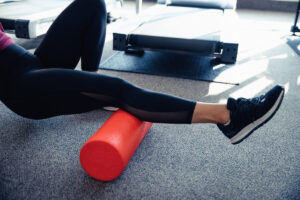In the pursuit of a healthy and well-rounded fitness routine, many individuals often wonder whether swimming and hitting the gym can be successfully integrated.
This article looks at the compatibility of these two forms of exercise and delves into the benefits and considerations of combining swimming with gym workouts.
Understanding how these activities can complement each other and fit into your lifestyle can help you make informed decisions about achieving your fitness goals.
Can Swimming And Gym Be Done Together?
Yes, swimming and going to the gym can be done together in a balanced fitness routine. Combining these activities can provide a well-rounded workout, as swimming offers cardiovascular and full-body strength benefits, while the gym can be used for targeted strength training and flexibility exercises. However, it’s essential to plan your schedule to allow for adequate rest and recovery between sessions to prevent overtraining and ensure optimal results.
The Benefits of Swimming and Gym Workouts
Combining swimming and gym workouts offers a multitude of benefits for individuals seeking a well-rounded fitness routine. Here are some of the key advantages:
1. Full-Body Workout: Swimming engages virtually every muscle group in the body.
It provides an excellent cardiovascular workout while also toning and strengthening muscles, making it an ideal complement to gym exercises that can target specific muscle groups.
2. Cardiovascular Health: Swimming is a highly effective aerobic exercise that improves heart health, increases lung capacity, and enhances overall cardiovascular fitness.
This complements gym workouts that can focus on strength but might lack the same cardiovascular intensity.
3. Low-Impact Option: Swimming is a low-impact exercise, which means it’s gentle on the joints.
This makes it an excellent choice for individuals with joint pain or those looking to reduce the risk of injury, especially when combined with gym workouts that may involve more impact.
4. Enhanced Flexibility: Gym workouts can sometimes lead to muscle stiffness.
Swimming, with its fluid motions, promotes flexibility and range of motion. Combining both activities can help maintain suppleness in your muscles and joints.
5. Variation and Motivation: The variety offered by switching between swimming and gym workouts can keep your fitness routine exciting and prevent boredom, making it more likely that you’ll stick with your exercise plan long-term.
6. Weight Management: Swimming is a calorie-burning exercise that can aid in weight management.
Pairing it with gym workouts for strength training can help build lean muscle mass, which in turn increases your resting metabolic rate.
7. Mental Health Benefits: Both swimming and gym workouts have been linked to reduced stress and improved mood.
Combining these activities can provide a holistic approach to mental well-being.
8. Customizable Workouts: You have the flexibility to tailor your fitness routine to your specific goals.
Whether you want to focus on building strength, improving endurance, or achieving a balanced physique, integrating swimming and gym workouts allows for customization.
9. Cross-Training Effect: The cross-training effect of combining these activities can help prevent overuse injuries.
Alternating between swimming and gym workouts gives certain muscle groups a break while others are engaged, reducing the risk of strain or imbalances.
10. Social and Recreational Aspects: Swimming can be a social and recreational activity, offering opportunities for group classes or outdoor swims.
Combining it with gym workouts allows you to enjoy the camaraderie of group activities while still benefiting from the gym’s equipment and targeted exercises.
Cardiovascular Fitness
Cardiovascular fitness, often referred to as aerobic fitness, is a fundamental pillar of overall health and well-being.
It reflects the ability of the cardiovascular and respiratory systems to efficiently supply oxygen to working muscles during physical activity.
Achieving and maintaining good cardiovascular fitness has a profound impact on various aspects of health.
Regular aerobic exercise, such as running, cycling, swimming, or brisk walking, strengthens the heart, enabling it to pump blood more efficiently and reducing the resting heart rate.
This improved cardiovascular efficiency not only enhances endurance and stamina but also lowers the risk of heart disease and other cardiovascular conditions.
Additionally, aerobic workouts stimulate the growth of new blood vessels, improving circulation and oxygen delivery throughout the body, which can positively affect overall vitality and longevity.
Cardiovascular Training in Swimming:
1. Freestyle Intervals: Perform intervals of freestyle swimming, alternating between high-intensity sprints and recovery laps.
For example, swim four lengths of the pool at a high intensity, then swim two lengths at a moderate pace for recovery. Repeat this pattern for a set duration or a specific number of rounds.
2. Distance Swimming: Challenge your endurance by swimming longer distances at a steady pace.
Aim to gradually increase the distance you swim over time. This can help build your cardiovascular stamina.
3. Swim Drills: Incorporate swim drills like kicking with a kickboard or using paddles and a pull buoy.
These drills can increase your heart rate while also focusing on technique and strength.
4. Open Water Swimming: If possible, take your swimming workouts to open water, such as a lake or the ocean.
The uneven terrain and currents add an extra challenge, making it an excellent cardiovascular workout.
5. Swimming Ladder: Swim intervals in a ladder format, starting with shorter sprints and progressively increasing the distance in each interval.
For example, swim 25 meters, 50 meters, 75 meters, 100 meters, and then reverse the ladder back down.
Cardiovascular Training in the Gym:
1. Treadmill Running: Utilize the treadmill for cardiovascular workouts. Incorporate interval training by alternating between walking, jogging, and running at different speeds and incline levels.
2. Stationary Cycling: Use a stationary bike for high-intensity interval training (HIIT) sessions. Pedal at maximum effort for a short duration, followed by a recovery phase of lower intensity.
Repeat this pattern.
3. Elliptical Trainer: The elliptical machine provides a low-impact way to improve cardiovascular fitness.
Experiment with interval programs or vary your resistance levels for intensity.
4. Rowing Machine: Rowing is an excellent full-body cardiovascular workout.
Row at a moderate pace for a few minutes, then increase the intensity by rowing faster or with more resistance for short bursts.
5. Jump Rope: Incorporate jump rope sessions into your gym routine for a fun and effective cardio workout.
Jump continuously for set durations, increasing the intensity with double unders or high knees.
6. Stair Climbing: Use the stair climber machine or find a set of stairs to climb. Start with a steady climb and add intervals of faster-paced climbing to elevate your heart rate.
7. Group Fitness Classes: Join group fitness classes like spinning, aerobics, or dance classes at the gym for structured cardiovascular workouts with a social aspect.
8. Circuit Training: Create a circuit of bodyweight exercises, incorporating activities like jumping jacks, burpees, mountain climbers, and squat jumps.
Perform each exercise for a set duration with minimal rest between exercises.
Strength Training: Leveraging the Gym

“Strength Training: Leveraging the Gym” is an important aspect of a well-rounded fitness routine, and it can significantly enhance your physical capabilities and overall health.
Gyms offer a variety of equipment and tools that provide unique advantages for strength training, making it a valuable component of your fitness regimen.
One of the primary advantages of gym-based strength training is the availability of resistance equipment, including free weights, machines, and cable systems.
These tools allow you to target specific muscle groups with precision, enabling you to design a tailored workout plan to meet your fitness goals.
Whether you’re looking to build muscle mass, improve muscular endurance, or increase overall strength, the gym offers a wide range of resistance options to suit your needs.
Compound exercises, another hallmark of gym workouts, play a major role in strength training.
These movements engage multiple muscle groups simultaneously, promoting functional strength that can benefit daily activities and athletic performance.
Exercises like squats, deadlifts, and bench presses challenge your body to work as a cohesive unit, improving coordination, stability, and balance.
Additionally, the controlled environment of the gym allows you to progressively increase resistance over time, a fundamental principle of strength training known as progressive overload.
By gradually lifting heavier weights or increasing resistance levels, you can continually challenge your muscles and promote muscle growth and development.
Gym workouts also offer valuable flexibility in terms of workout variety.
You can switch between machines, free weights, and bodyweight exercises to keep your routine fresh and prevent plateaus.
This variation not only keeps you engaged and motivated but also ensures that you target different muscle groups from various angles, promoting a well-rounded physique.
Flexibility and Mobility
“Flexibility and Mobility: The Swimming Advantage” highlights how swimming’s unique qualities contribute to improved joint flexibility and enhanced range of motion in the body.
Swimming, with its continuous and rhythmic movements, naturally promotes joint flexibility as limbs move through a wide range of motion in the water.
The resistance provided by water forces the muscles to work efficiently, aiding in the elongation of muscles and increased joint mobility.
Moreover, swimming’s emphasis on bilateral movement patterns helps in achieving balance and symmetry in the body, addressing imbalances that might arise from other forms of exercise.
This advantage extends beyond the pool, as the enhanced flexibility and mobility gained from swimming can positively impact daily life activities and complement other physical pursuits, making it a valuable addition to a well-rounded fitness routine.
Overcoming Challenges
1. Time Constraints:
• Challenge: Balancing work, family, and other commitments with your fitness routine can be challenging.
• Solution: Schedule your workouts in advance, prioritize them as you would any other appointment, and consider shorter, more intense workouts when time is limited.
2. Plateaus:
• Challenge: Hitting a plateau where you’re not making progress in terms of strength or fitness gains can be frustrating.
• Solution: Change your workout routine regularly to keep your body challenged. Set new goals, seek guidance from a trainer, or consider incorporating periodization into your training plan.
3. Injuries and Overuse:
• Challenge: Injuries or overuse issues like tendinitis can hinder your fitness journey.
• Solution: Pay attention to your body’s signals, don’t push through pain, and seek medical advice if necessary. Work on mobility and flexibility, and consider cross-training to prevent overuse injuries.
4. Boredom:
• Challenge: Doing the same workouts repeatedly can become monotonous.
• Solution: Change up your routine by trying new exercises, classes, or sports. Incorporate variety to keep things fresh and engaging.
5. Nutrition and Recovery:
• Challenge: Poor nutrition and insufficient recovery can affect your performance and progress.
• Solution: Focus on a balanced diet that supports your fitness goals and prioritizes post-workout nutrition. Get adequate sleep and incorporate rest days into your routine.
6. Self-Doubt:
• Challenge: Doubting your abilities or feeling self-conscious in the gym or pool.
• Solution: Remember that everyone starts somewhere, and progress takes time. Seek support from friends, join fitness groups, or consider working with a personal trainer or coach for guidance and confidence-building.
7. Financial Constraints:
• Challenge: Gym memberships or swimming facilities can be costly.
• Solution: Explore budget-friendly options like community centers or outdoor swimming spots.
You can also invest in basic home workout equipment to save on gym fees.
8. Environmental Factors:
• Challenge: Weather or location constraints might impact your ability to swim or access the gym.
• Solution: Adapt your workouts to the available conditions. For example, consider indoor swimming when the weather is unfavorable or find alternative exercise options during gym closures.
9. Inconsistent Schedule: –
• Challenge: An irregular schedule can disrupt your workout routine.
• Solution: Be flexible and adapt your workouts to fit your schedule. Consider shorter, more intense workouts during busy periods, or follow a structured program that accommodates your availability.
Overcoming challenges in swimming and gym workouts requires patience, adaptability, and determination.
By addressing these obstacles with the right strategies and mindset, you can continue progressing toward your fitness goals and maintaining a healthy lifestyle.
Post you may like: Is Swimming An Aerobic Exercise?
Injury Prevention and Safety

Injury prevention and safety are paramount when participating in both swimming and gym workouts.
These activities, while beneficial for overall fitness, can pose unique risks if not approached with caution and proper knowledge.
Here are some specific injury prevention and safety considerations for swimming and gym workouts:
Swimming:
1. Warm-Up and Cool-Down: Just like any other exercise, it’s essential to warm up before swimming and cool down afterward.
Begin with a few minutes of light swimming or dynamic stretches before your main swim, and finish with some gentle stretches in the pool.
2. Technique and Form: Proper swimming technique is fundamental in preventing overuse injuries. Consider taking lessons or working with a swim coach to ensure your form is correct.
3. Breathing: Be mindful of your breathing technique. Avoid holding your breath, as it can lead to increased pressure in your chest and potential strain.
4. Hydration: Even though you’re in the water, it’s still important to stay hydrated. Dehydration can affect your performance and increase the risk of muscle cramps.
5. Safety in Open Water: If you swim in open water, such as lakes or the ocean, be aware of potential hazards like currents, marine life, and weather conditions.
Swim in designated areas and consider using a brightly colored swim cap or floatation device for visibility.
Gym Workouts:
1. Proper Warm-Up: Prioritize warming up your muscles before lifting weights or engaging in intense gym workouts. This can include light cardio and dynamic stretching.
2. Strength Training Technique: Ensure you use proper form when lifting weights to avoid strains, sprains, or muscle imbalances.
If you’re unsure, consider working with a fitness trainer.
3. Spotter for Heavy Lifts: If you’re lifting heavy weights, have a spotter present to assist you in case you cannot complete a repetition safely.
4. Weight Progression: Gradually increase the weight or resistance you use in your workouts.
Avoid sudden jumps in intensity, as this can lead to injuries.
5. Proper Equipment Use: Familiarize yourself with gym equipment and use it as intended. Adjust machines and weights to your body size and comfort.
6. Rest and Recovery: Allow adequate time for muscle recovery between strength training sessions. Overtraining can lead to injuries and burnout.
7. Nutrition: Maintain a balanced diet to support your gym workouts. Proper nutrition is essential for muscle recovery and overall performance.
8. Hydration: Stay hydrated throughout your gym session. Dehydration can lead to fatigue and reduced performance.
9. Gym Etiquette: Be considerate of others in the gym. Wipe down equipment after use and follow any posted gym rules or guidelines.
10. Safety Measures: If you engage in high-intensity workouts like HIIT (High-Intensity Interval Training), ensure you have adequate space, and use proper technique to minimize the risk of accidents.
In both swimming and gym workouts, it’s necessary to prioritize your safety and well-being.
Post you may be interested in: Is Swimming Considered Strength Training?
Nutrition and Recovery
Nutrition and recovery are paramount considerations when embarking on a dual training regimen that combines swimming and gym workouts.
Proper nutrition serves as the foundation for fueling your body to meet the physical demands of both activities.
It’s essential to ensure an adequate intake of carbohydrates, which provide the primary energy source for workouts, and protein, crucial for muscle repair and growth.
Timing your meals and snacks around your training sessions is key to optimizing performance.
Pre-workout nutrition should consist of easily digestible carbohydrates and hydration to sustain energy levels, while post-workout meals should focus on replenishing glycogen stores with a combination of carbohydrates and lean proteins.
Additionally, maintaining proper hydration is vital, especially when swimming, as water immersion can lead to significant fluid loss.
Adequate hydration supports muscle function, temperature regulation, and overall well-being during dual training.
Equally vital to success in dual training is recovery.
Intense exercise, whether in the pool or the gym, places strain on muscles and joints.
Effective recovery strategies help prevent injury and promote ongoing progress.
Incorporate active recovery sessions, gentle stretching, and self-myofascial release techniques like foam rolling into your routine to alleviate muscle soreness and maintain flexibility.
Prioritize sleep as a major component of recovery, as it allows the body to repair and regenerate..
Key Takeaways
In conclusion, the combination of gym workouts and swimming undeniably works together harmoniously to create a comprehensive and effective fitness regimen.
The synergy between these two activities offers a multitude of benefits, encompassing cardiovascular health, muscular strength, flexibility, and injury prevention.
Swimming’s unique qualities contribute to enhanced mobility and flexibility, while gym workouts provide the tools to build muscle and strength systematically.
When integrated thoughtfully and consistently, this dual approach to fitness not only promotes a balanced physique but also fosters holistic well-being.
So, whether you’re striving to improve your athletic performance, maintain overall fitness, or simply lead a healthier lifestyle, the dynamic blend of gym and swimming has the potential to propel you towards your fitness goals with remarkable synergy.



